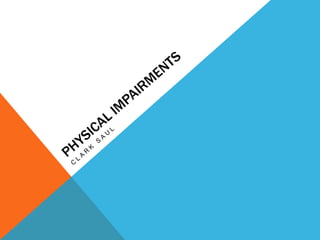
Clark[1]
- 1. Physical Impairments Clark saul
- 2. Introductory video Josh Blue – Standup Comedian: http://www.youtube.com/watch?v=gT9-VNOTJa4 Behavioral Objectives: 1.Raise your hand before speaking 2. Listen to other while they are speaking 3. RESPECT!!! - http://www.youtube.com/watch?v=t7tfoFzTdPQ&feature=fvst
- 4. Some are congenital- present at birth, and other are acquired through disease or injury.
- 5. Physical health problems can have little or no effect on school performance and some do not require any special adaptations.
- 6. For the ones that do need special adaptations, it is necessary for the teacher to adapt their lesson in the areas needed such as mobility, communication, and basic skills.
- 7. Needs can be very different from student to student. One student with lower limb paralysis might be out going and active, whereas another may be shy.
- 9. Teachers may need to provide additional instruction for students with frequent absences, modification of classroom, and adaptations of activities.
- 10. Because some students develop their disabilities after an accident or disease it is hard to make a single list of symptoms. (see handout)
- 12. A frequent adaptation is mobility in the classroom.
- 13. Some students have trouble learning because of extensive absences, fatigue, learning problems, behavioral disorders, and intellectual disorders.Indicators
- 15. Teachers should be aware of general health status of their students and take note of any changes.
- 16. There is an increasing number of students with extensive health problems that are entering the educational system.
- 17. With this movement , more students that are medically fragile ( use heart monitors, oxygen tanks) are being placed in the general ed. classrooms.
- 19. -Seizures interfere with the brains normal functions. They cause a child to have a sudden change in consciousness, movement, or sensation.
- 20. -Seizure Disorder can be used interchangeably with epilepsy.
- 21. -Having one seizure doesn’t mean a person is epileptic. It must occur more than once and have an unknown cause.Types: Three types. Generalized Seizures- when the electrical disturbance involves the whole brain. Partial Seizure-s- When only part of the brain is affected. Partial Seizure Secondarily Generalized- Starts in one part then spreads. Not Enough? – www.epilepsyfoundation.org
- 22. Inclusion tips to prevent infection Roll out 2 paper towel sections. One to dry your hands the other to turn off the faucet. Turn on the faucet. Wet hands under water. Apply soap. Work up a generous lather. Rub hands in a circular motion covering all parts of the hand. Each area is to be rubbed with soap ten times for 10-30 seconds. Rinse. Dry on the paper towel rolled out in the beginning. Discard in a receptacle. Turn off the faucet with the dry paper towel. Use the dry paper towel to open the door. If only hot air dryers are available, use a tissue or newspaper, or even clothing.
- 24. 10% of the students that receive special services have a physical disability.
- 25. Most common chronic illness is asthma.
- 26. 40 children per day are diagnosed with diabetes.
- 27. Cerebral Palsy is one of the most complex of all physical impairments because it results from brain damage.
- 28. Most students with physical impairment spend the majority of the day in the General Ed. Classroom.
- 29. Theodore Roosevelt had Asthma.Facts to Take Away
- 30. The students will have their left hand taped and will be given a cup with M&M’s inside. The students will attempt to pull the M&M’s out of the cup and then will be required to write a paragraph (with their taped hand) about what they learned from this activity, while they are writing they will be unexpectedly tossed a ball to catch. Gauntlet!